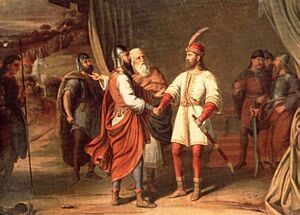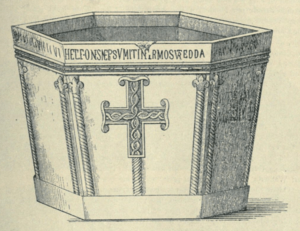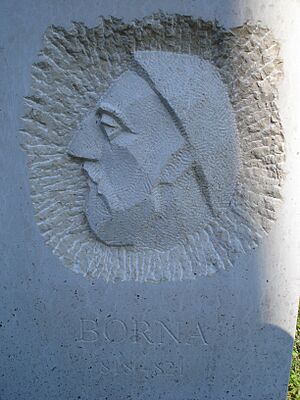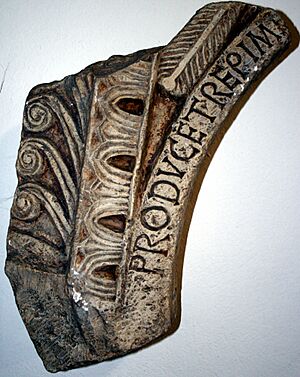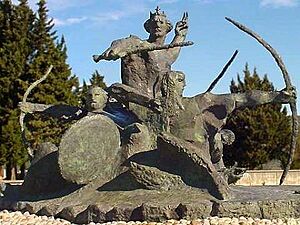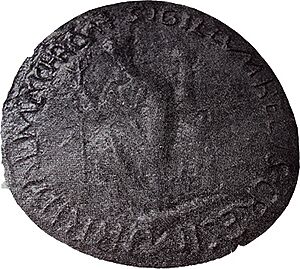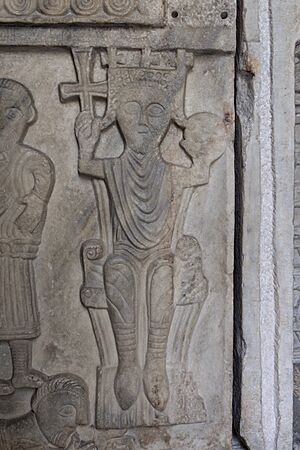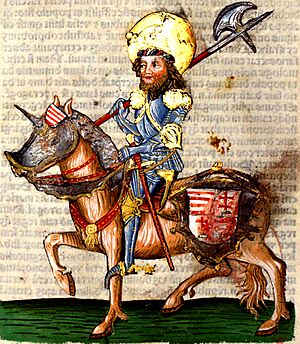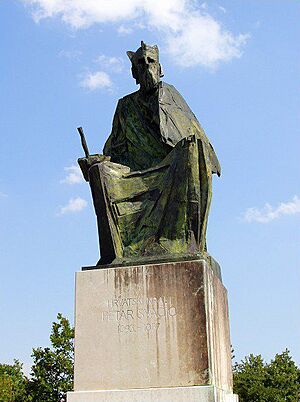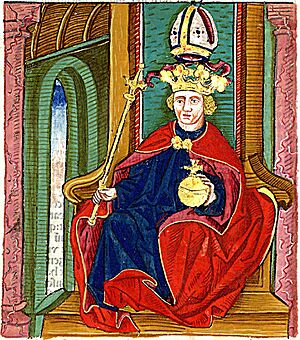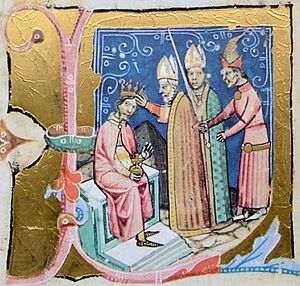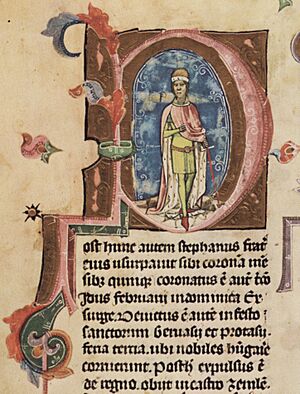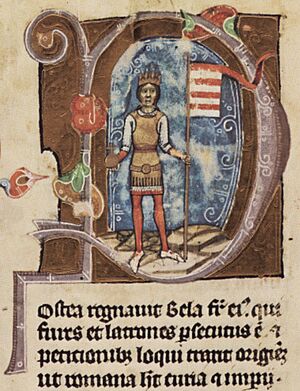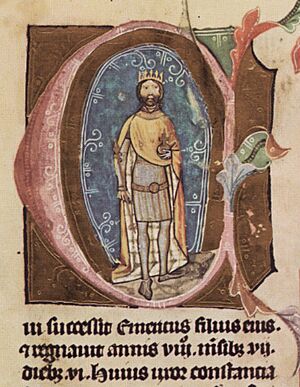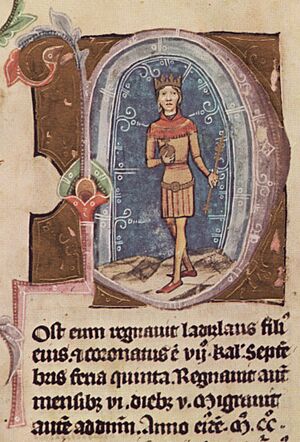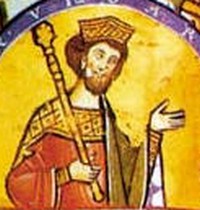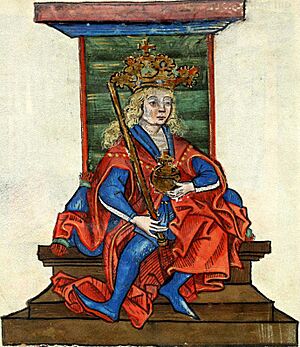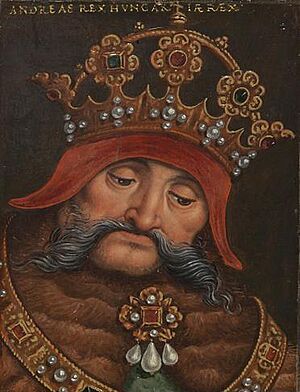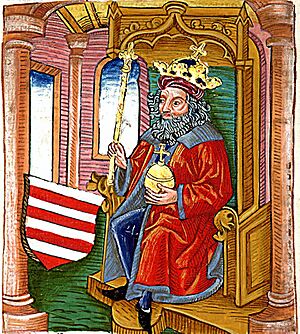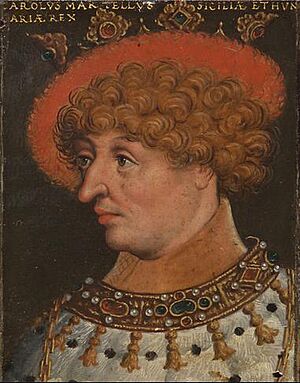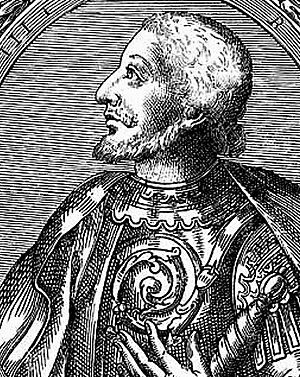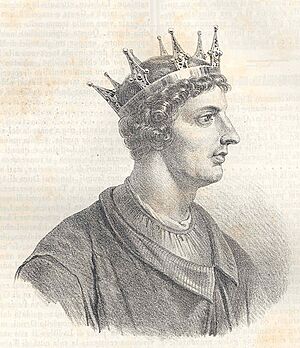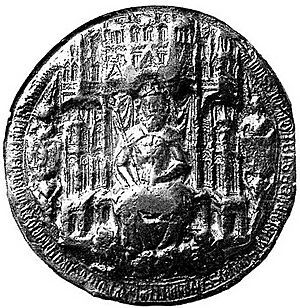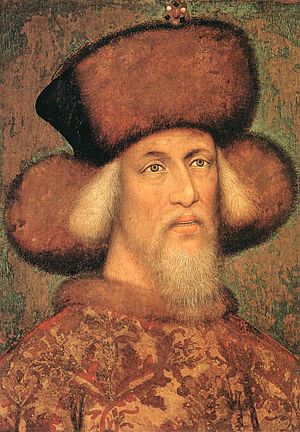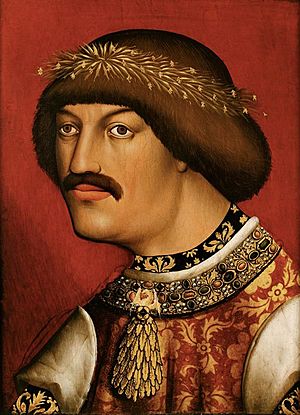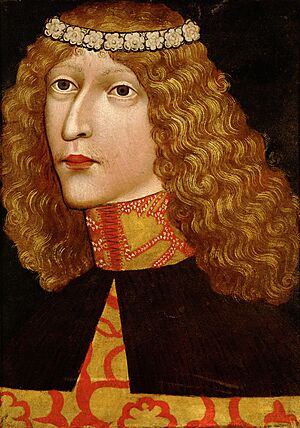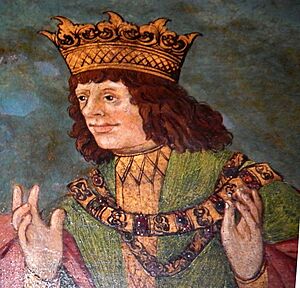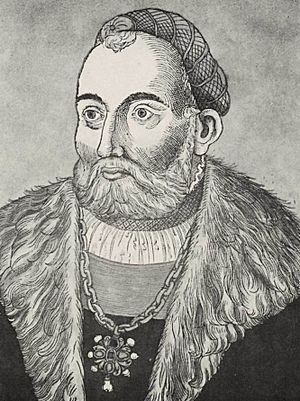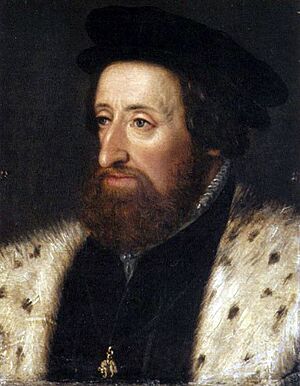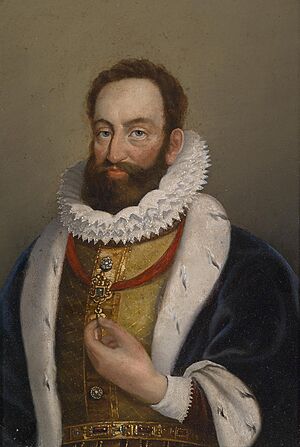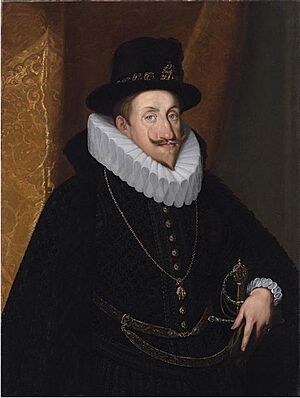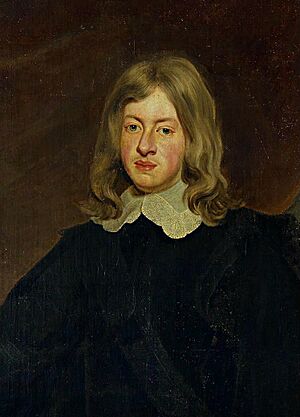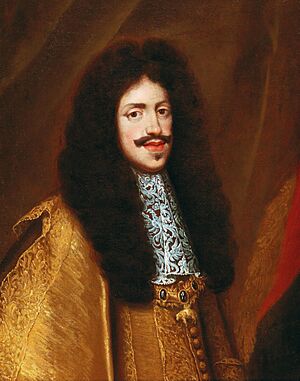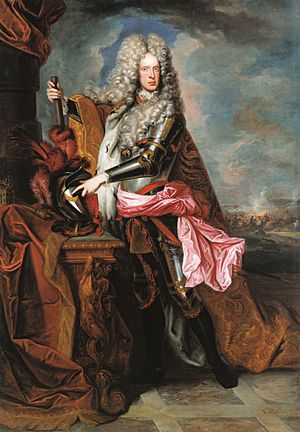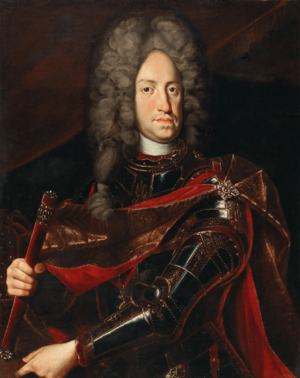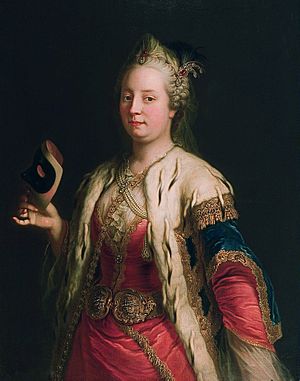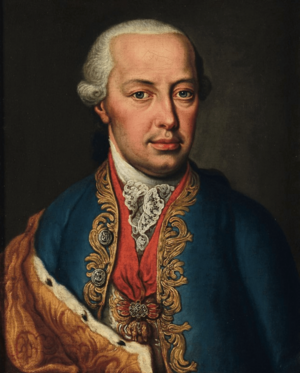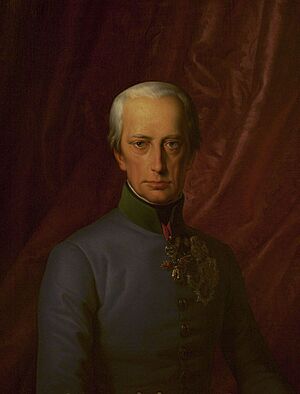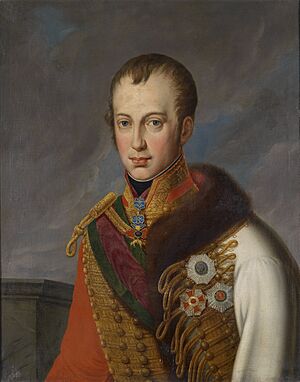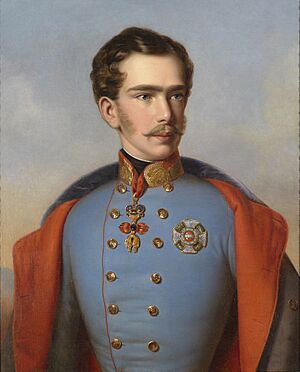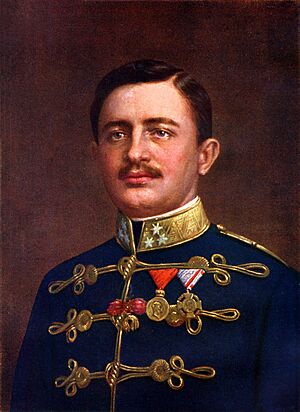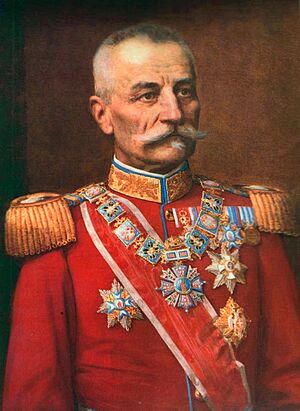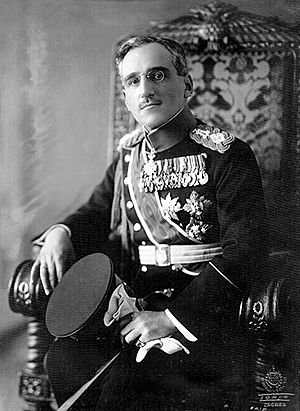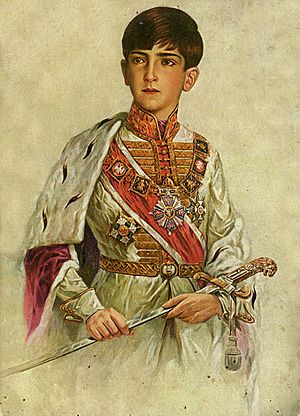List of dukes and kings of Croatia facts for kids
A list of dukes and kings of Croatia shows the rulers who led Croatia from its early days as a duchy to a kingdom. These leaders came from Croatian families and later from other European royal families.
Contents
- Early Croatian History
- Dukes of Lower Pannonia (8th Century–896)
- Dukes of Croatia (8th Century–925)
- Kings of Croatia (925–1102)
- Under the Hungarian Crown (1102–1527)
- Under the Habsburg Monarchy (1527–1918)
- Kings of Yugoslavia (1918–1945)
- King of the Independent State of Croatia (1941–1943)
- After World War II
- Images for kids
- What is a "Duke of Croatia"?
- See also
Early Croatian History
The story of how the Croats arrived in the Balkans isn't fully clear. Around the late 500s and early 600s, Croats moved from an area called White Croatia (which is now part of Galicia). A old story from the 900s says that the Croats came to their current home led by five brothers and two sisters. They bravely fought and pushed out the Pannonian Avars from the Roman area of Dalmatia.
Some people think one of the brothers, Chrobatos (Hrvat), gave his name to the Croats (Hrvati). However, most historians don't have enough proof for this idea. The Croats slowly started to become Christian in the 600s, during the time of a ruler named Porga.
First Croatian Leaders (7th Century)
These were some of the earliest known leaders of the Croats. They were called "archons," which means a chief ruler.
| Name | When they Ruled | Important Facts |
|---|---|---|
| Father of Porga | Early 600s | This leader was in charge when the Croats fought the Pannonian Avars. They got permission from Emperor Heraclius to settle in Dalmatia. |
| Porga | Early 600s | During Porga's rule, the Croats began to convert to Christianity. This happened around the time of Emperor Heraclius or Constans II. |
Dukes of Lower Pannonia (8th Century–896)
The flat lands of modern-day Croatia, known as the Pannonian plain, also had Slavic tribes living there long ago. History tells us about some of their rulers.
| Portrait | Name | Rule Started | Rule Ended | Important Facts |
|---|---|---|---|---|
| Vojnomir | around 790 | around 810 | ||
| Ljudevit | around 810 | around 823 | ||
| Ratimir | around 829 | around 838 | ||
| Braslav | around 882 | around 896 | His wife was named Ventescela. |
Dukes of Croatia (8th Century–925)
The Slavic tribes known as Croats settled in what is now Croatia around the early 7th century. Their rulers started to appear in historical records in the late 8th century.
A special baptismal font still exists today that mentions Višeslav as a duke. For a long time, Croatian historians thought he was a duke of the Croats. However, there isn't much clear proof for many of the things said about him.
| Portrait | Name | Rule Started | Rule Ended | Important Facts |
|---|---|---|---|---|
| Borna | around 810 | 821 | Borna was a leader under the Frankish Emperor Charlemagne. He was called the Duke of the Guduscani, and Duke of Dalmatia and Liburnia. Since Croats lived in these areas, he is seen as a Croatian duke. | |
| Vladislav | 821 | around 823 | He was Borna's nephew. | |
| Ljudemisl | around 823 | around 835 | Some old writings suggest he might have killed Ljudevit, the Pannonian duke. | |
| Mislav | around 835 | around 845 | ||
| The Trpimirović Family | ||||
| Trpimir | around 845 | 864 | He started the Trpimirović dynasty, a very important Croatian ruling family. | |
| Zdeslav | 864 | 864 | He was Trpimir's son. | |
| The Domagojević Family | ||||
| Domagoj | 864 | 876 | He took over from Zdeslav. | |
| Iljko | 876 | 878 | He was later killed during a civil war. | |
| The Trpimirović Family | ||||
| Zdeslav | 878 | 879 | He became ruler again after overthrowing Domagoj's son. He was killed by Branimir in May 879. | |
| The Domagojević Family | ||||
| Branimir | 879 | around 892 | His wife was Maruša (Mariosa), the earliest known Croatian female ruler. | |
| The Trpimirović Family | ||||
| Muncimir | 892 | 910 | He was Trpimir's son. He was also called Mutimir. | |
| Tomislav I | 910 | 925 | ||
Kings of Croatia (925–1102)
In a letter from 925, Pope John X called Tomislav I of the Trpimirović dynasty Rex Chroatorum, which means King of the Croats. After Tomislav I, all Croatian rulers used the title of King of Croatia. This is also shown by an old stone carving that mentions the earliest known Croatian queen, Domaslava, from the early 900s.
| Portrait | Name | Rule Started | Rule Ended | Important Facts |
|---|---|---|---|---|
| The Trpimirović Family | ||||
| Tomislav I | 925 | 928 | He might have been the son of Muncimir. After he died, civil wars made the country weaker, and some land, like Bosnia, was lost. He is traditionally seen as the first and most famous Croatian king. | |
| Trpimir II | 928 | 935 | He was either Tomislav's younger brother or his son. | |
| Krešimir I | 935 | 945 | He was the son of Trpimir II. | |
| Miroslav | 945 | 949 | He was the son of Krešimir I. | |
| Michael Krešimir II | 949 | 969 | He was Miroslav's younger brother. Michael Krešimir ruled with his wife, Queen Helen of Zadar. During their time, Croatia got back lands it had lost, including Bosnia. After Michael Krešimir died, his wife ruled as a guardian for their young son, Stephen Držislav. | |
| Helen of Zadar | 969 | 976 | She ruled as a guardian for her son Stephen Držislav from 969 until she died on October 8, 976. | |
| Stephen Držislav | 969 | 997 | He was the son of Michael Krešimir and Queen Helen of Zadar. He received royal symbols from the Byzantine Emperor and was crowned by the Archbishop of Split in Biograd in 988. He is considered the first crowned Croatian king. | |
| Svetoslav Suronja | 997 | 1000 | He was the oldest son of King Stephen Držislav. He was meant to be the next king but was removed from power by his brothers, Krešimir III and Gojslav. | |
| Gojslav | 1000 | 1020 | He was Svetoslav Suronja's younger brother. He ruled together with Krešimir III. | |
| Krešimir III | 1000 | 1030 | He was Svetoslav Suronja's younger brother. He ruled alone after Gojslav died in 1020. | |
| Stephen I | 1030 | 1058 | He was the son of Krešimir III. | |
| Peter Krešimir IV the Great | 1058 | 1074 | He was the son of Stephen I. During his rule, the Croatian Kingdom was at its strongest. Near the end of his life, since he had no sons, Peter Krešimir chose Demetrius Zvonimir to be his heir. | |
| Demetrius Zvonimir | 1075 | 1089 | He was a cousin of Peter Krešimir IV. He received royal symbols from the Pope and was crowned at the Basilica of Saint Peter and Moses in Salona in 1075 or 1076. He married Princess Helen, who was the daughter of King Béla I of Hungary. | |
| Stephen II | 1089 | 1090/91 | He was the son of Gojslav II, who was King Peter Krešimir IV's younger brother. He was supposed to be the next king after Peter Krešimir IV. However, the people and church chose Demetrius Zvonimir instead in 1075. He was the last ruler from the Trpimirović family and the last native king of Croatia to rule the entire medieval Croatian Kingdom. | |
| The Árpád Family | ||||
| Ladislaus I | 1091 | 1095 | After King Demetrius Zvonimir died in 1089, King Ladislaus I of Hungary ruled in Slavonia. After Stephen II died, he took over a large part of Croatia and became King of Croatia in 1091. He sent his nephew Álmos to rule as a duke for him, but only Hungarian nobles recognized him. Ladislaus claimed the throne because his sister was married to the late Croatian king Zvonimir, who had no living son. However, Hungary would not fully control Croatia until the rule of his successor, Coloman. | |
| The Snačić Family | ||||
| Petar Snačić | 1093/1095 | 1097 | Petar Snačić, a Croatian Ban (a high official), was chosen by Croatian nobles to rule. He became king during a time of great tension in the Kingdom. He fought against Coloman of Hungary for control of Croatia and was killed at the Battle of Gvozd Mountain in 1097. Petar was the last native Croatian king. From 1102 onwards, the Kings of Hungary were also Kings of Croatia, as the two crowns were joined. | |
Under the Hungarian Crown (1102–1527)
From 1102, the King of Hungary also ruled the Kingdom of Croatia. This was agreed upon with the Croatian nobles. A viceroy, called a ban, and a parliament, called a sabor, governed Croatia for the king. In 1409, Ladislaus of Naples sold his rights to Dalmatia to the Republic of Venice.
| Portrait | Name | When they Ruled | Spouse(s) | Important Facts |
|---|---|---|---|---|
| The Árpád Family | ||||
| Koloman | 1102 - February 3, 1116 | Euphemia of Kiev | Koloman was King of Hungary from 1095 and King of Croatia from 1102 until his death. He was recognized by a council of Croatian nobles and crowned King of Croatia in 1102. | |
| Stjepan II | February 3, 1116 - April 3, 1131 | A daughter of Robert I of Capua | He was Koloman's son. | |
| Bela II the Blind | April 3, 1131 - February 13, 1141 | Helena of Serbia | He was Stjepan II's uncle and Koloman's brother. | |
| Gejza II | February 13, 1141 - May 31, 1162 | Euphrosyne of Kiev (married 1146) | He was the son of Bela II the Blind. | |
| Stjepan III | May 31, 1162 - March 4, 1172 | Agnes of Austria (married 1168) | He was Gejza II's son. His rule was challenged from 1162 to 1163. | |
| Ladislav II | May 31, 1162 - January 14, 1163 | None | He was a rebel anti-king and Gejza II's younger brother. He was the son of Bela II. | |
| Stjepan IV | January 14, 1163 - June 1163 | Maria Komnene | He was another rebel anti-king and Gejza II's younger brother. He was the son of Bela II. | |
| Bela III | March 4, 1172 - April 13, 1196 | Agnes of Antioch (married 1172-died 1184) Margaret of France (married 1186) | He was Stjepan III's brother and Gejza II's son. | |
| Emerik | April 13, 1196 - November 30, 1204 | Constance of Aragon (married 1198) | He was Bela III's son. | |
| Ladislav III | November 30, 1204 - May 7, 1205 | None | He was Emerik's son. He was crowned when he was only 4 or 5 years old and died six months later. | |
| Andrija II | May 7, 1205 - September 21, 1235 | Gertrude of Merania (died 1213) Yolanda of Courtenay (married 1215-died 1233) Beatrice of Este (married 1234) | He was Ladislav III's uncle and Bela III's son. In 1222, he issued a special document called the Golden Bull. This document set out the rights of noblemen, including their right to not obey the king if he broke the law. | |
| Bela IV | September 21, 1235 - May 3, 1270 | Maria Laskarina | He was Andrija II's son. He ruled during the First Mongol invasion (1241–1242). In 1242, he issued another Golden Bull that made Zagreb and Samobor free royal cities. | |
| Stjepan V | May 3, 1270 - August 6, 1272 | Elizabeth the Cuman | He was Bela IV's son. He was also Prince of Slavonia from 1246 to 1257. | |
| Ladislav IV the Cuman | August 6, 1272 - July 10, 1290 | Elizabeth of Sicily | He was Stjepan V's son. He lived with the nomadic Cuman tribes, which the Catholic church didn't like. Because of this, he was removed from the church. | |
| Andrija III the Venetian | August 4, 1290 - January 14, 1301 | Fenenna of Kuyavia (died 1295) Agnes of Austria (married 1296) | He was a distant cousin of Ladislav IV and the grandson of Andrija II. His rule was challenged by Carlo Martel and Carlo I. | |
| The Přemyslid Family | ||||
| Vjenceslav (Anti-king) | August 27, 1301 - October 9, 1305 | Viola of Teschen (married 1305) | He was a great-great-grandson of Bela IV and King of Bohemia. His claim to the throne was challenged by Carlo I. The Pope declared his rule invalid. | |
| The Wittelsbach Family | ||||
| Otto (Anti-king) | October 9, 1305 - May 1307 | None | He was a grandson of Bela IV and Duke of Lower Bavaria. His claim was challenged by Carlo I. | |
| The Anjou Family | ||||
| Karlo Martel | 1290 - August 12, 1295 | Clemence of Austria (died 1293/1295) | He was chosen by Pope Nicholas IV to be the successor of his uncle, Ladislav IV. His title as king was recognized by the Šubić and Kőszegi noble families. He was crowned in Croatia. His rule was challenged by Andrija III. | |
| Karlo I | January 14, 1301 - July 16, 1342 | Maria of Galicia (disputed) Maria of Bytom (married 1306-died 1317) Beatrice of Luxembourg (married 1318-died 1319) Elizabeth of Poland (married 1320) | He was Karlo Martel's son. He was also called Carlo Robert. His rule was challenged by Vjenceslav and Otto from 1301 to 1307. | |
| Ludovik I the Great | July 16, 1342 - September 11, 1382 | Margaret of Bohemia (died 1349) Elizabeth of Bosnia (married 1353) | He was also King of Poland from 1370 to 1382. | |
| Marija | September 11, 1382 - December 1385 (first reign) and February 24, 1386 - May 17, 1395 (second reign) | Žigmund (married 1385) | She married Žigmund (Sigismund) of Luxembourg after he invaded Upper Hungary in 1385. After Karlo II was killed in 1386, Marija began her second rule as co-king with her husband Žigmund. | |
| Karlo II | December 31, 1385 - February 24, 1386 | Margaret of Durazzo | He was also King of Naples. After Marija gave up the throne, Karlo II of Naples was crowned King. He was hurt in an assassination attempt on February 7, 1386, and died on February 24 of the same year. | |
| Ladislav V | 1390-1414 | Costanza Chiaramonte (marriage ended 1392) Mary of Lusignan (married 1403-died 1404) Mary of Enghien (married 1406) | He was Karlo II's son. He claimed the crowns of Hungary and Croatia from 1390, against Marija and Žigmund. He was crowned but only controlled Zadar. | |
| The Kotromanić Family | ||||
| Stjepan Tvrtko | 1390-1391 | Doroteja Bugarska (married 1374) | Tvrtko managed to take over large parts of Slavonia, Dalmatia, and Croatia. In May 1390, cities and islands in Dalmatia gave up to Tvrtko. He then called himself "king of Rascia, Bosnia, Dalmatia, Croatia, and Pomorje." His sudden death in 1391 stopped his family from keeping control of Croatian lands. | |
| Stjepan Dabiša | 1391-1394 | Jelena Gruba (married 1391) | In the first years of his rule, Dabiša kept Tvrtko's Kingdom of Bosnia together. This included Bosnia, Croatia, Dalmatia, and other areas. Dabiša later gave up Croatia and Dalmatia to the Hungarian king and agreed to recognize him as his feudal lord and future heir to the Bosnian throne. | |
| The Luxembourg Family | ||||
| Žigmund | March 31, 1387 - December 9, 1437 | Marija (died 1395) Barbara of Celje (married 1305) | He was the son of Holy Roman Emperor and King of Bohemia Charles IV. He ruled with his wife Marija until she died in 1395. He became King of Bohemia in 1419 and was chosen as Holy Roman Emperor in 1433. | |
| The Habsburg Family | ||||
| Albert I | December 18, 1437 - October 27, 1439 | Elizabeth of Luxembourg | He was Žigmund's son-in-law. He was also King of Bohemia and Germany from 1438 until he died in 1439. He was the first Habsburg king of Croatia. | |
| The Jagiellon Family | ||||
| Vladislav I | May 15, 1440 - November 10, 1444 | None | He was also King of Poland from 1434 until he supposedly died at the Battle of Varna. His rule was challenged by Ladislav V, Albert I's son. | |
| The Habsburg Family | ||||
| Ladislav V the Posthumous | November 10, 1444 - November 23, 1457 | None | He was Albert I's son, born in 1440 after his father died. He spent most of his life as a captive. His rule was challenged by Vladislav I between 1440 and 1444. He had no children and was the last of his line of the Habsburg family. | |
| The Hunyadi Family | ||||
| Matija I | January 24, 1458 - April 6, 1490 | Catherine of Poděbrady (married 1463-died 1464) Beatrice of Naples (married 1475) | The nobles chose him as king. He was the son of John Hunyadi. He was also King of Bohemia from 1469 until he died in 1490, a title he fought for with Vladislav II. | |
| The Jagiellon Family | ||||
| Vladislav II | July 15, 1490 - May 13, 1516 | Beatrice of Naples (married 1490-marriage ended 1500) Anne of Foix-Candale (married 1502-died 1506) | He was also King of Bohemia from 1471. Hungarian nobles chose him as king after his supporters defeated Matija I's son. He died in 1516. | |
| Ludovik II | May 13, 1516 - August 29, 1526 | Mary of Austria | He was also King of Bohemia from 1516 until he died in 1526 at the Battle of Mohács. He was the last king not from the Habsburg family. | |
| The Zápolya Family | ||||
| Ivan I (Anti-king) | November 10, 1526 - July 22, 1540 | Isabella Jagiellon (married 1539) | He claimed the throne with support from Hungarian nobles and later Suleiman the Magnificent. His rule was challenged by Ferdinand I. Ivan I made a deal with Ferdinand I to recognize his right to unite Hungary after Ivan I's death. However, shortly after his son Ivan was born, Ivan I gave his kingdom to his son on his deathbed. | |
| Ivan II (Anti-king) | September 13, 1540 - August 16, 1570 | None | He was Ivan I's son. Supporters of Ivan I chose him as King of Hungary. His claim was challenged by Ferdinand I and Maximilian. He was never crowned. | |
Under the Habsburg Monarchy (1527–1918)
On January 1, 1527, the Croatian Parliament met in Cetin to choose Ferdinand I of the Habsburg family as the new King of Croatia. The Habsburg rulers later took over the lands of Dalmatia after the Napoleonic wars. The Kingdom of Dalmatia was a special territory of the Austrian Empire (1815–1867) and later part of Austria-Hungary (1867–1918).
| Portrait | Name | When they Ruled | Spouse(s) | Important Facts |
|---|---|---|---|---|
| The Habsburg Family | ||||
| Ferdinand I | January 1, 1527 - July 25, 1564 | Anne of Hungary (died 1547) | He was the brother-in-law of Ludovik II. He claimed the throne based on an agreement between the Jagiellon and Habsburg families. The Sabor (Croatian Parliament) elected him King in January 1527. | |
| Maximilian | September 8, 1563 - October 12, 1576 | Maria of Spain | He was Ferdinand I's son. He ruled during the Siege of Szigetvár and the Croatian–Slovene Peasant Revolt. | |
| Rudolf | September 25, 1572 - June 26, 1608 | None | He was Maximilian's son. He ruled during the Battle of Sisak. He gave up his throne to his younger brother Matthias II. | |
| Matija II | June 26, 1608 - March 20, 1619 | Anna of Tyrol (died 1618) | He was Rudolf's brother and Maximilian's son. | |
| Ferdinand II | July 1, 1618 - February 15, 1637 | Eleonora of Mantua (married 1622) | He was Matija II's cousin and Ferdinand I's grandson. In 1630, he issued a law called Statuta Valachorum. This law put Vlachs (mostly Orthodox Serbs) in the Military Frontier directly under Vienna's rule, taking away the Sabor's power over them. | |
| Ferdinand III | December 8, 1625 - April 2, 1657 | Maria Anna of Spain (married 1631-died 1646) Maria Leopoldine of Austria (married 1648-died 1649) Eleonora of Mantua (married 1651) | He was Ferdinand II's son. He helped end the Thirty Years War. | |
| Ferdinand IV | June 16, 1647 - July 9, 1654 | None | He was Ferdinand III's son and co-king. | |
| Leopold I | June 27, 1657 - May 5, 1705 | Margaret Theresa of Spain (married 1666-died 1673) Claudia Felicitas of Austria (married 1673-died 1676) Eleonore Magdalene of Neuburg (married 1676) | He was Ferdinand III's son. He stopped the Zrinski–Frankopan Conspiracy and took away the Sabor's right to elect a king. In 1669, he started the University of Zagreb. | |
| Josip I | May 5, 1705 - April 17, 1711 | Wilhelmina Amalia of Brunswick | He was Leopold I's son. | |
| Karlo III | April 11, 1711 - October 20, 1740 | Elizabeth Christina of Brunswick | He was Josip I's brother and Leopold I's son. He issued a rule called the Pragmatic Sanction. This rule allowed his daughter Marija Terezija to become queen if there were no male heirs. | |
| Marija Terezija | October 20, 1740 - November 29, 1780 | Francis I, Holy Roman Emperor (died 1765) | She was Karlo III's daughter. She divided Croatia into counties. In 1767, she created a Croatian Royal Council, but she ended it in 1779. She made important changes to the military, economy, and schooling. | |
| Josip II | November 29, 1780 - February 20, 1790 | None | He was Marija Terezija's son. He ended serfdom (a type of forced labor) and tried to make German the main language in Croatian lands. | |
| Leopold II | February 20, 1790 - March 1, 1792 | Maria Louisa of Spain | He was Josip II's brother and Marija Terezija's son. | |
| Franjo | March 1, 1792 - March 2, 1835 | Maria Theresa of Sicily (died 1807)
Maria Ludovica of Modena (married 1808-died 1816) Caroline Augusta of Bavaria (married 1816) |
He was Leopold II's son. He brought the Habsburg Monarchy together into the Austrian Empire when the Holy Roman Empire fell apart. He was the last Holy Roman Emperor. | |
| Ferdinand V | September 28, 1830 - December 2, 1848 | Maria Anna of Sardinia (married 1831) | He was Franjo's son. Because he had epilepsy, he gave up his throne to his nephew Franjo Josip during the Revolutions of 1848. Ferdinand V died in 1875. | |
| Franjo Josip | December 2, 1848 - November 21, 1916 | Elizabeth of Bavaria (married 1854-died 1898) | He was Ferdinand V's nephew and Franjo's grandson. He was the longest-reigning Croatian monarch. During his rule, Croatian lands (Croatia, Slavonia, and Dalmatia) were united by Ban Josip Jelačič in 1848. In 1867, he changed the monarchy into two parts: Austrian and Hungarian. From 1868, the Kingdom of Croatia-Slavonia was a self-governing kingdom within Hungary. | |
| Blessed Karlo IV | November 21, 1916 - April 1, 1922 | Zita of Parma | He was Franjo Josip's grand-nephew. In his coronation oath to the Sabor (Croatian Parliament), he recognized the unity of Croatia, Dalmatia, and Slavonia with Rijeka. He reigned until 1918, when he stopped taking part in state affairs but did not officially give up his throne. The Sabor ended Croatia's union with Hungary and Austria on October 29, 1918, but never officially removed King Karlo IV from his title. He spent his last years trying to bring back the monarchy until he died in 1922. The Catholic Church later made him a saint. | |
Kings of Yugoslavia (1918–1945)
After World War I and the end of Austria-Hungary, Croatia joined a new country called the State of Slovenes, Croats and Serbs. After a short time of ruling itself, this state became part of the Kingdom of Serbs, Croats and Slovenes under the Karađorđević family. The kingdom's name changed to the Kingdom of Yugoslavia in 1929. In 1920, after the Treaty of Rapallo, Istria and parts of Dalmatia became part of Italy. Based on an agreement in 1939, the Banate of Croatia was created. Under this agreement, an elected Sabor and a Ban chosen by the king would decide on internal matters in Croatia.
| Portrait | Name | When they Ruled | Spouse(s) | Important Facts |
|---|---|---|---|---|
| The Karađorđević Family | ||||
| Petar I | December 1, 1918 - August 16, 1921 | None | He was the son of Aleksandar, Prince of Serbia. After King Alexander I Obrenović was killed in 1903, Peter Karađorđević became the new king of Serbia. Later, he became King of the Serbs, Croats, and Slovenes. | |
| Aleksandar | August 16, 1921 - October 9, 1934 | Maria of Romania (married 1922) | He was Petar I's son. He changed the country's name to the Kingdom of Yugoslavia and started a royal dictatorship. He was killed in 1934 in Marseille. | |
| Petar II | October 9, 1934 - November 29, 1945 | Alexandra of Greece (married 1944) | He was Aleksandar's son. His uncle Pavle served as a regent (someone who rules for a young king) until 1941. He was part of the Yugoslav government-in-exile after the Axis invasion of Yugoslavia in April 1941. The monarchy was officially ended in Yugoslavia on November 29, 1945. | |
King of the Independent State of Croatia (1941–1943)
In 1941, Croatia was taken over by the Axis powers during World War II. The Independent State of Croatia was set up as a state controlled by Nazi Germany and Fascist Italy. Soon after it was created, the government passed laws to make the country a kingdom. Three days later, the Treaties of Rome were signed. The Italian Prince Aimone of Savoy-Aosta was chosen to be King of Croatia. Many Adriatic islands and part of Dalmatia were taken by Italy. On September 10, 1943, the Independent State of Croatia said the Treaties of Rome were no longer valid and took back the part of Dalmatia that had been given to Italy.
| Portrait | Name | When they Ruled | Spouse(s) | Important Facts |
|---|---|---|---|---|
| The Savoy Family | ||||
| Tomislav II (King-designate) | May 18, 1941 - July 31, 1943 | Irene of Greece | Tomislav II set up a Croatian royal office in Florence and later in Rome. He first refused to become king because he was against Italy taking over the Dalmatia region. So, some sources call him the king-designate (chosen king). He gave up his claim on July 31, 1943, after Benito Mussolini was removed from power. | |
After World War II
- List of heads of state of Yugoslavia (1945–1991)
- List of presidents of Croatia (1991–present)
- List of prime ministers of Croatia (1991–present)
Images for kids
-
Kingdom of Croatia-Slavonia (1868–1918). The official version had St. Stephen's crown.
What is a "Duke of Croatia"?
The title Duke of Croatia has been used in different ways:
- The Doges of Venice (leaders of Venice) used this title, with permission from the Byzantine Empire, starting around 1100. This was when Hungary was taking over the Kingdom of Croatia. They used it until a peace agreement with Hungary in 1358.
- The Dukes of Merania, whose land was next to Croatia, were sometimes called Dukes of Croatia in old historical writings.
- Various Hungarian noblemen who were given power in the South Slavic lands added "Croatia" to their title of Duke of Slavonia in the 1200s and 1300s.
See also
- History of Croatia
- Timeline of Croatian history
- Croatian nobility
- Croatian Parliament
- Ban of Croatia
- Ban of Slavonia
- List of Hungarian monarchs (1102-1526)
- List of rulers of Austria (1527-1918)
- List of heads of state of Yugoslavia (1918-1991)
- List of presidents of Croatia (1991–present)
- List of prime ministers of Croatia (1991–present)


